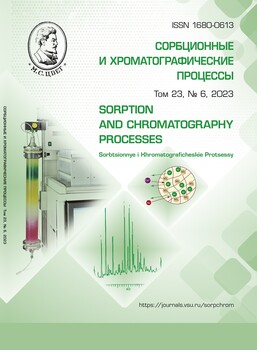Investigation of catalytic properties of glutathione reductase obtained by chromatographic methods from the liver of rats with paracetamol-induced liver damage upon administration of 6-hydroxy-2,2,2,4-trimethyl-1,2-dihydroquinoline
Abstract
The aim of the present study was to analyze some catalytic and regulatory properties of the enzyme preparation of glutathione reductase (GR, EC 1.6.4.2.) obtained from rat liver using gel filtration and ion exchange chromatography under conditions of paracetamol-induced liver injury (PILI) and administration of 6-hydroxy-2,2,4-trimethyl-1,2-dihydroquinoline (DHQ). Laboratory animals (Rattus norvegicus rats of the Wistar line) were divided into 3 groups. The animals of the control group were orally administered vaseline oil. The second group consisted of rats with PILI induced by a single oral administration of paracetamol at a dose of 1000 mg/kg body weight dissolved in 1 cm3 of vaseline oil. Animals of the third group were modeled by PILI and orally administered with DHQ at a dose of 50 mg per 1 kg body weight dissolved in 1 cm3 of 1% starch, 1 hour and 12 hours after paracetamol administration. Liver and serum were collected 24 hours after paracetamol administration. GR activity was measured on a spectrophotometer at 340 nm wavelength. The enzyme was purified from rat liver by ammonium sulfate fractionation, gel filtration through Sephadex G-25, and ion exchange chromatography on DEAE-cellulose. The total amount of protein in the samples was measured using the BCA protein assay kit. GR was obtained from the liver of rats treated with DHQ on the background of PILI with a 32-fold purification degree. Using the method of double inverse Lineweaver-Burk coordinates it was shown that administration of DHQ to rats was accompanied by a decrease in the affinity of the enzyme for NADPH, as compared to the indicators at pathology. The introduction of isocitrate into the spectrophotometric medium resulted in a less pronounced increase in the activity of GR from the liver of animals treated with DHQ on the background of PILI, compared to the second group of rats. The enzyme from the liver of animals of the third group was characterized by a more significant decrease in activity when glucose-6-phosphate was introduced into the reaction medium. Citrate had a less pronounced regulatory effect on GR from the liver of rats treated with DHQ on the background of pathology, relative to the indicators of animals with PILI. The changes in enzyme properties demonstrated may be due to conformational changes in the molecule resulting from the inhibition effect of DHQ on the intensity of free radical-induced oxidation, which develops against the background of the toxic effect of paracetamol metabolites.
Downloads
References
Fontana R.D. Acute liver failure including acetaminophen overdose. North Am Medical Center. 2008; 92: 761-94.
Newsome P.N., Plevris J.N., Nelson L.J., Hayes P.C. Animal models of fulminant hepatic failure: a critical evaluation. Liver Transpl. 2000; 6: 21-31. https://doi.org/10.1002/lt.500060110
Paz V., Morán M. L., Alcántara N. L., Freixo C., Andrade R.J., Lucena M.I., Cubero F.J. Oxidative Stress in Drug-Induced Liver Injury (DILI): From Mechanisms to Biomarkers for Use in Clinical Practice. Antioxidants, 2021; 3: 390. https://doi.org/10.3390/antiox10030390
Hwang K.A., Hwang Y., Hwang H.J., Park N.Y. Hepatoprotective Effects of Radish (Raphanus sativus L.) on Acetaminophen-Induced Liver Damage via Inhibiting Oxidative Stress and Apoptosi. Nutrients, 2022; 23. 5082. https://doi.org/10.3390/nu14235082
Bailey C.A., Srinivasan L.J., McGeachin R.B. The effect of ethoxyquin on tissue peroxidation and immune status of single comb White Leghorn cockerels. Poultry Science. 1996; 75 (9): 1109- 1112. https://doi.org/10.3382/ps.0751109
Yassir F. B. Y., Sert Y., Kandri R. Synthesis, crystal structure, spectroscopic characterization, Hirshfeld surface analysis, molecular docking studies and DFT calculations, and antioxidant activity of 2-oxo-1,2-dihydroquinoline-4-carboxylate derivatives. Journal of Molecular Structure, 2019; 1188: 255-268. https://doi.org/10.1016/j.molstruc.2019.03.103
Takahashi H., Bekkali Y., Capolino A.J., Gilmore T., Goldrick S.E., Nelson R.M., Thomson D. Discovery and SAR study of novel dihydroquinoline containing glucocorticoid receptor ligands. Bioorganic & Medicinal Chemistry Letters. 2006; 6: 1549-1552. https://doi.org/10.1016/j.bmcl.2005.12.043
Mitchel J.R., Jallow D.G., Potter W.Z. Acetaminophen-induced hepatic necrosisss. Protective role of glutathione. J. Pharmacol. Exp. Ther. 2003; 187: 211-217. https://doi.org/10.3390/antiox8090395
Popov S.S., Agarkov A.A., Kryl'skiy E.D., Shul'gin K.K., Popova T.N., Safonova O.A. The activity of glutathione reductase under liver pathologies and enzyme purification by ion-exchange chromatography for the catalytic properties study. Sorbtsionnye I Khromatograficheskie Protsessy. 2017; 17(1): 168-175. https://doi.org/10.17308/sorpchrom.2017.17/367 (In Russ.)
Carlberg I, Bengt M. Glutathione reductase. Methods in enzymology. Academic press. 1985; 113: 484-490.
Ancizu, Saioa et al. New quinoxaline derivatives as potential MT₁ and MT₂ receptor ligands. Molecules (Basel, Switzerland) vol. 2012; 17(7): 7737-57. https://doi.org/10.3390/molecules17077737
Kasaikina O.T., Lobanova T.V., Fentsov D.V., Ivanov Yu.A. Paths of conversion of the tetrahydroqunoline series upon interaction with peroxy radical. News of the Academy of Sciences of the USSR. Chemistry series. 1983; 32 (10): 2002-2006. https://doi.org/10.1007/bf00955758
Orhan Püsküllü, et al. Recent studies of antioxidant quinoline derivatives. Mini reviews in medicinal chemistry. 2013; 13(3): 365-72. https://doi.org/10.2174/138955713804999793
Panteleon, Vassiliki et al. Synthesis of some new spiropyranoquinolines and evaluation of their free radical scavenging activity. Chemical & pharmaceutical bulletin. 2009; 57(5): 446-52. https://doi.org/10.1248/cpb.57.446
Sankaran, Mathan et al. Synthesis, antioxidant and toxicological study of novel pyrimido quinoline derivatives from 4-hydroxy-3-acyl quinolin-2-one. Bioorganic & medicinal chemistry letters. 2010; 20(23): 7147-51. https://doi.org/10.1016/j.bmcl.2010.09.018
Jaeschke, Hartmut et al. Acetaminophen-induced Liver Injury: from Animal Models to Humans. Journal of clinical and translational hepatology. 2014; 2(3): 153-61. https://doi.org/10.14218/JCTH.2014.00014







